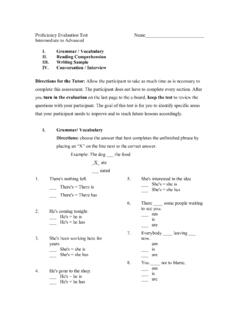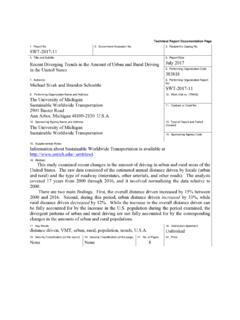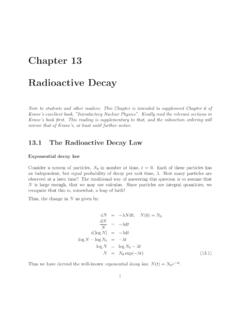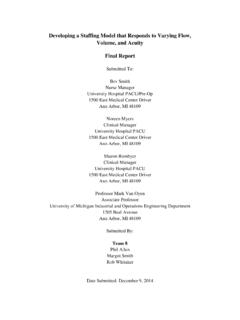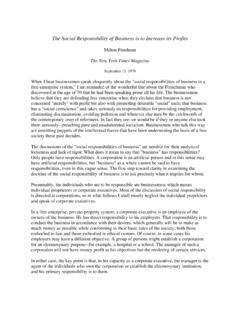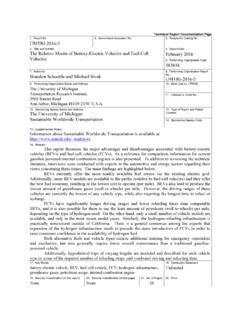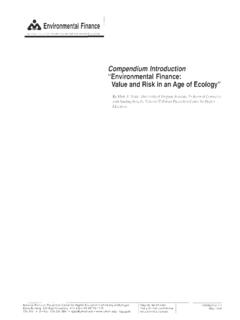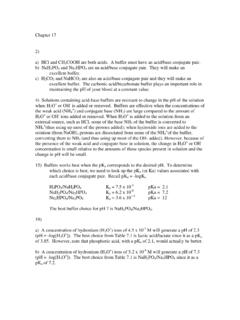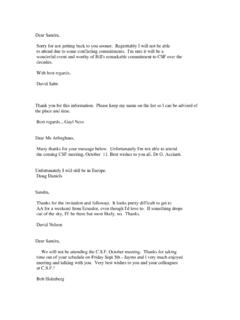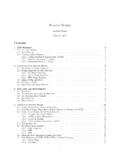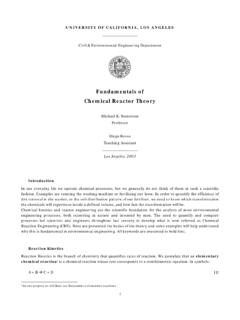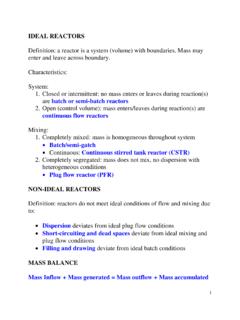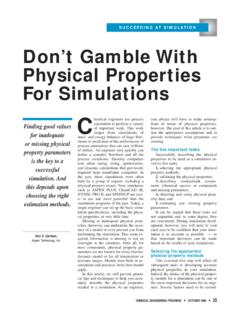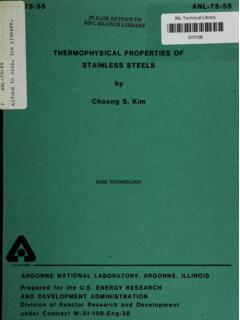Transcription of Distributions of Residence Times for Chemical Reactors
1 Page 867 Wednesday, September 17, 2008 5:01 PM. Distributions 13. of Residence Times for Chemical Reactors Nothing in life is to be feared. It is only to be understood. Marie Curie Overview In this chapter we learn about nonideal Reactors , that is, Reactors that do not follow the models we have developed for ideal CSTRs, PFRs, and PBRs. In Part 1 we describe how to characterize these nonideal Reactors using the Residence time distribution function E(t), the mean Residence time tm, the cumulative distribution function F(t), and the variance 2. Next we evaluate E(t), F(t), tm, and 2 for ideal Reactors , so that we have a reference point as to how far our real ( , nonideal) reactor is off the norm from an ideal reactor.
2 The functions E(t) and F(t) will be developed for ideal PPRs, CSTRs and laminar flow Reactors . Examples are given for diagnosing prob- lems with real Reactors by comparing tm and E(t) with ideal Reactors . We will then use these ideal curves to help diagnose and troubleshoot bypassing and dead volume in real Reactors . In Part 2 we will learn how to use the Residence time data and functions to make predictions of conversion and exit concentrations. Because the resi- dence time distribution is not unique for a given reaction system, we must use new models if we want to predict the conversion in our nonideal reactor. We present the five most common models to predict conversion and then close the chapter by applying two of these models, the segregation model and the maximum mixedness model, to single and to multiple reactions.
3 After studying this chapter the reader will be able to describe the cumulative F(t) and external age E(t) and Residence - time distribution functions, and to recognize these functions for PFR, CSTR, and laminar flow Reactors . The reader will also be able to apply these functions to calculate the conver- sion and concentrations exiting a reactor using the segregation model and the maximum mixedness model for both single and multiple reactions. 867. Page 868 Wednesday, September 17, 2008 5:01 PM. 868 Distributions of Residence Times for Chemical Reactors Chap. 13. General Characteristics The Reactors treated in the book thus far the perfectly mixed batch, the plug-flow tubular, the packed bed, and the perfectly mixed continuous tank Reactors have been modeled as ideal Reactors .
4 Unfortunately, in the real world we often observe behavior very different from that expected from the exem- plar; this behavior is true of students, engineers, college professors, and chem- ical Reactors . Just as we must learn to work with people who are not perfect, so the reactor analyst must learn to diagnose and handle Chemical Reactors We want to analyze whose performance deviates from the ideal . Nonideal Reactors and the princi- and characterize ples behind their analysis form the subject of this chapter and the next. nonideal reactor behavior. Part 1 Characterization and Diagnostics The basic ideas that are used in the distribution of Residence Times to charac- terize and model nonideal reactions are really few in number.
5 The two major uses of the Residence time distribution to characterize nonideal Reactors are 1. To diagnose problems of Reactors in operation 2. To predict conversion or effluent concentrations in existing/available Reactors when a new reaction is used in the reactor System 1 In a gas liquid continuous-stirred tank reactor (Figure 13-1), the gaseous reactant was bubbled into the reactor while the liquid reactant was fed through an inlet tube in the reactor's side. The reaction took place at the gas liquid interface of the bubbles, and the product was a liquid. The continu- ous liquid phase could be regarded as perfectly mixed, and the reaction rate was proportional to the total bubble surface area.
6 The surface area of a partic- ular bubble depended on the time it had spent in the reactor. Because of their different sizes, some gas bubbles escaped from the reactor almost immediately, while others spent so much time in the reactor that they were almost com- Figure 13-1 Gas liquid reactor. Page 869 Wednesday, September 17, 2008 5:01 PM. Sec. General Characteristics 869. pletely consumed. The time the bubble spends in the reactor is termed the bub- ble Residence time . What was important in the analysis of this reactor was not the average Residence time of the bubbles but rather the Residence time of each Not all molecules bubble ( , the Residence time distribution ). The total reaction rate was found are spending the by summing over all the bubbles in the reactor.
7 For this sum, the distribution same time in the reactor. of Residence Times of the bubbles leaving the reactor was required. An under- standing of Residence - time Distributions (RTDs) and their effects on Chemical reactor performance is thus one of the necessities of the technically competent reactor analyst. System 2 A packed-bed reactor is shown in Figure 13-2. When a reactor is packed with catalyst, the reacting fluid usually does not flow through the reac- tor uniformly. Rather, there may be sections in the packed bed that offer little resistance to flow, and as a result a major portion of the fluid may channel through this pathway. Consequently, the molecules following this pathway do not spend as much time in the reactor as those flowing through the regions of high resistance to flow.
8 We see that there is a distribution of Times that mole- cules spend in the reactor in contact with the catalyst. Figure 13-2 Packed-bed reactor. System 3 In many continuous-stirred tank Reactors , the inlet and outlet pipes are close together (Figure 13-3). In one operation it was desired to scale up pilot plant results to a much larger system. It was realized that some short cir- cuiting occurred, so the tanks were modeled as perfectly mixed CSTRs with a bypass stream. In addition to short circuiting, stagnant regions (dead zones) are often encountered. In these regions there is little or no exchange of material with the well-mixed regions, and, consequently, virtually no reaction occurs We want to find ways of determining the Bypassing dead volume and amount of bypassing.
9 Dead zone Figure 13-3 CSTR. Page 870 Wednesday, September 17, 2008 5:01 PM. 870 Distributions of Residence Times for Chemical Reactors Chap. 13. there. Experiments were carried out to determine the amount of the material effectively bypassed and the volume of the dead zone. A simple modification of an ideal reactor successfully modeled the essential physical characteristics of the system and the equations were readily solvable. The three concepts Three concepts were used to describe nonideal Reactors in these exam- RTD. Mixing ples: the distribution of Residence Times in the system, the quality of mixing, Model and the model used to describe the system. All three of these concepts are con- sidered when describing deviations from the mixing patterns assumed in ideal Reactors .
10 The three concepts can be regarded as characteristics of the mixing in nonideal Reactors . One way to order our thinking on nonideal Reactors is to consider model- ing the flow patterns in our Reactors as either CSTRs or PFRs as a first approx- imation. In real Reactors , however, nonideal flow patterns exist, resulting in ineffective contacting and lower conversions than in the case of ideal Reactors . We must have a method of accounting for this nonideality, and to achieve this goal we use the next-higher level of approximation, which involves the use of macromixing information (RTD) (Sections to ). The next level uses microscale (micromixing) information to make predictions about the conver- sion in nonideal Reactors .
